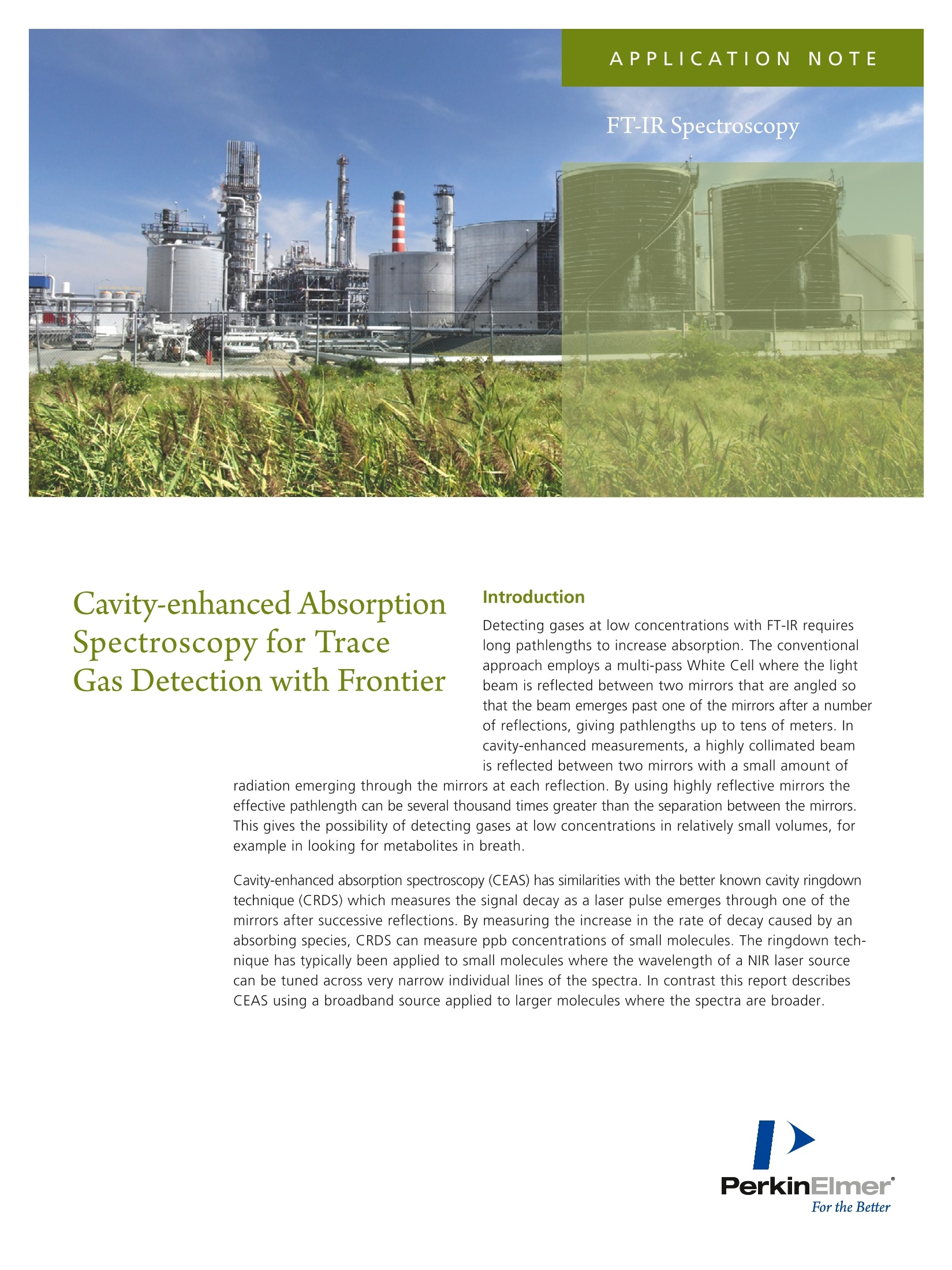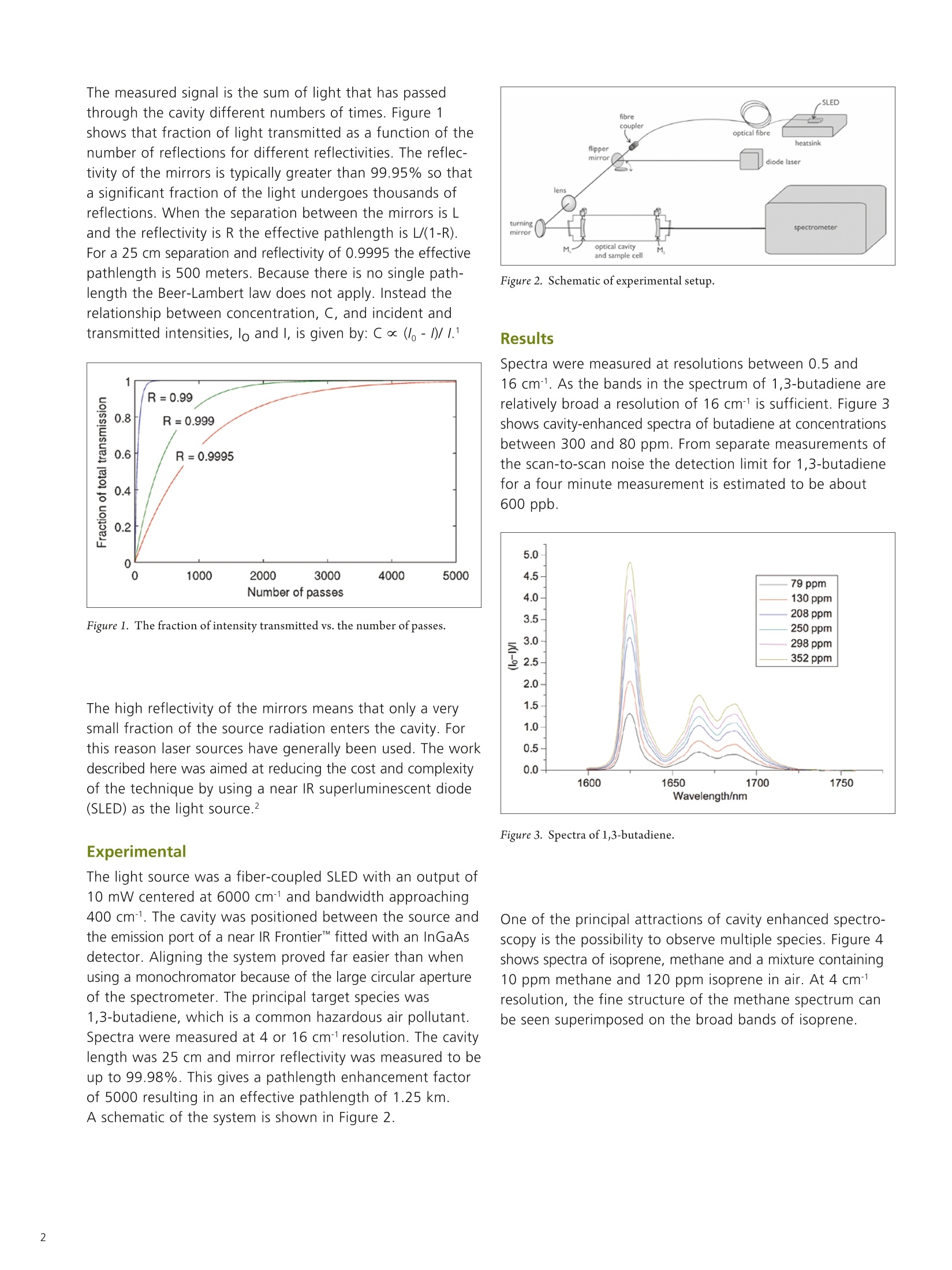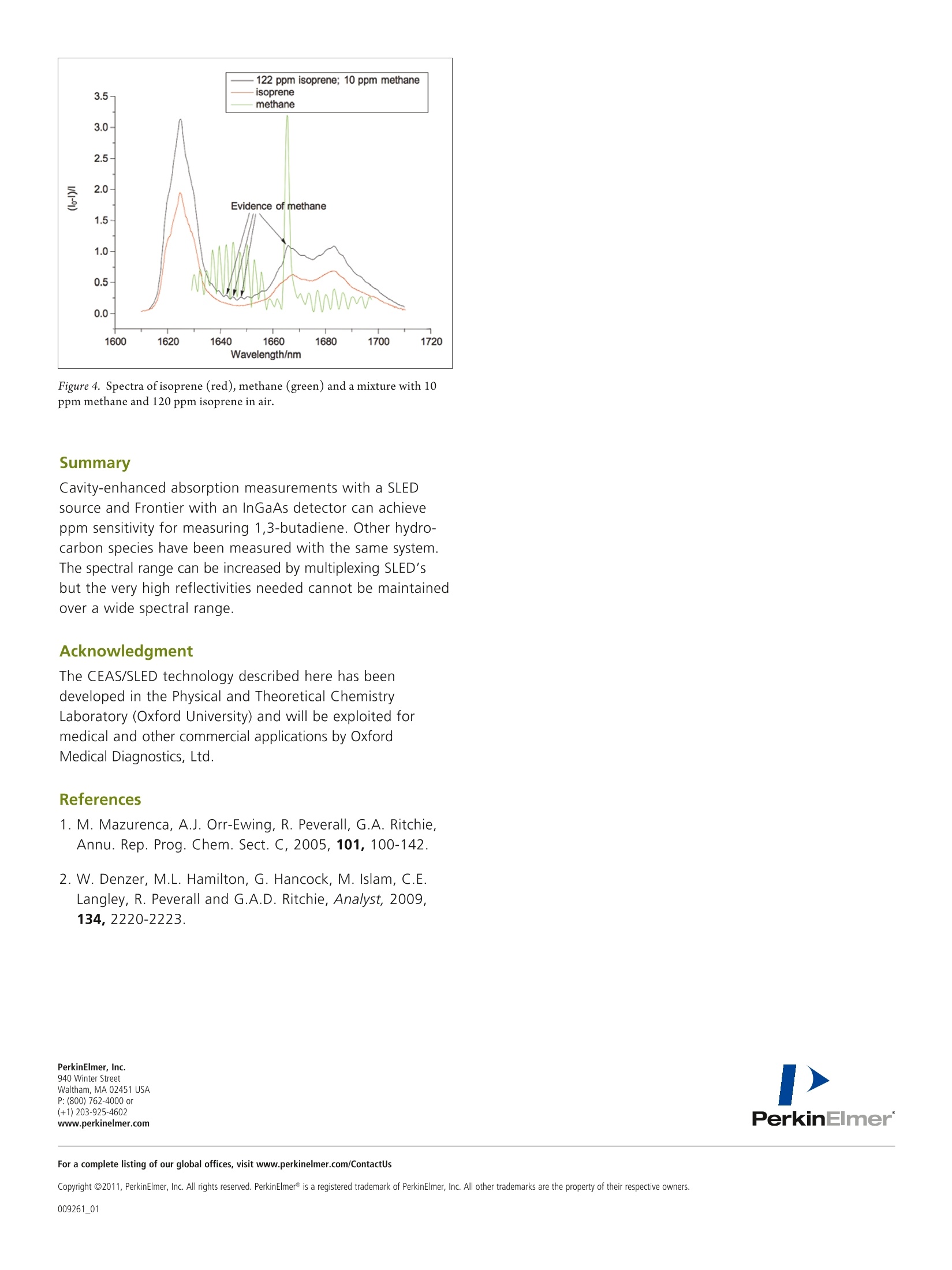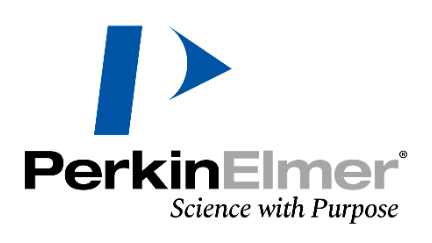方案详情
文
文章介绍使用Frontier的腔增强吸收光谱技术进行了微量气体的检测,结果表明测量1,3-丁二烯可达到ppm水平,同时也可测量其它碳氢化合物。
方案详情

Cavity-enhanced AbsorptionSpectroscopy for TraceGas Detection with Frontier Introduction Detecting gases at low concentrations with FT-IR requireslong pathlengths to increase absorption. The conventionalapproach employs a multi-pass White Cell where the lightbeam is reflected between two mirrors that are angled sothat the beam emerges past one of the mirrors after a numberof reflections, giving pathlengths up to tens of meters. Incavity-enhanced measurements, a highly collimated beamjs reflected between two mirrors with a small amount of radiation emerging through the mirrors at each reflection. By using highly reflective mirrors theeffective pathlength can be several thousand times greater than the separation between the mirrors.This gives the possibility of detecting gases at low concentrations in relatively small volumes, forexample in looking for metabolites in breath. Cavity-enhanced absorption spectroscopy (CEAS) has similarities with the better known cavity ringdowntechnique (CRDS) which measures the signal decay as a laser pulse emerges through one of themirrors after successive reflections. By measuring the increase in the rate of decay caused by anabsorbing species, CRDS can measure ppb concentrations of small molecules. The ringdown tech-nique has typically been applied to small molecules where the wavelength of a NIR laser sourcecan be tuned across very narrow individual lines of the spectra. In contrast this report describesCEAS using a broadband source applied to larger molecules where the spectra are broader. The measured signal is the sum of light that has passedthrough the cavity different numbers of times. Figure 1shows that fraction of light transmitted as a function of thenumber of reflections for different reflectivities. The reflec-tivity of the mirrors is typically greater than 99.95% so thata significant fraction of the light undergoes thousands ofreflections. When the separation between the mirrors is Land the reflectivity is R the effective pathlength is L/(1-R).For a 25 cm separation and reflectivity of 0.9995 the effectivepathlength is 500 meters. Because there is no single path-length the Beer-Lambert law does not apply. Instead therelationship between concentration, C, and incident andtransmitted intensities, lo and I, is given by: C(lo-1)/ 1.1 Figure 1. The fraction of intensity transmitted vs. the number of passes. The high reflectivity of the mirrors means that only a verysmall fraction of the source radiation enters the cavity. Forthis reason laser sources have generally been used. The workdescribed here was aimed at reducing the cost and complexityof the technique by using a near IR superluminescent diode(SLED) as the light source. Experimental The light source was a fiber-coupled SLED with an output of10 mW centered at 6000 cm and bandwidth approaching400 cm-1. The cavity was positioned between the source andthe emission port of a near IR Frontier" fitted with an InGaAsdetector. Aligning the system proved far easier than whenusing a monochromator because of the large circular apertureof the spectrometer. The principal target species was1,3-butadiene, which is a common hazardous air pollutant.Spectra were measured at 4 or 16 cm-1resolution. The cavitylength was 25 cm and mirror reflectivity was measured to beup to 99.98%. This gives a pathlength enhancement factorof 5000 resulting in an effective pathlength of 1.25 km.A schematic of the system is shown in Figure 2. Figure 2. Schematic of experimental setup. Results Spectra were measured at resolutions between 0.5 and16 cm-1. As the bands in the spectrum of 1,3-butadiene arerelatively broad a resolution of 16 cmis sufficient. Figure 3shows cavity-enhanced spectra of butadiene at concentrationsbetween 300 and 80 ppm. From separate measurements ofthe scan-to-scan noise the detection limit for 1,3-butadienefor a four minute measurement is estimated to be about600 ppb. Figure 3. Spectra of 1,3-butadiene. One of the principal attractions of cavity enhanced spectro-scopy is the possibility to observe multiple species. Figure 4shows spectra of isoprene, methane and a mixture containing10 ppm methane and 120 ppm isoprene in air. At 4 cm.-1resolution, the fine structure of the methane spectrum canbe seen superimposed on the broad bands of isoprene. Figure 4. Spectra of isoprene (red), methane(green) and a mixture with 10ppm methane and 120 ppm isoprene in air. Summary Cavity-enhanced absorption measurements with a SLEDsource and Frontier with an InGaAs detector can achieveppm sensitivity for measuring 1,3-butadiene. Other hydro-carbon species have been measured with the same system.The spectral range can be increased by multiplexing SLED'sbut the very high reflectivities needed cannot be maintainedover a wide spectral range. Acknowledgment The CEAS/SLED technology described here has beendeveloped in the Physical and Theoretical ChemistryLaboratory (Oxford University) and will be exploited formedical and other commercial applications by OxfordMedical Diagnostics, Ltd. References 1. M. Mazurenca, A.J. Orr-Ewing, R. Peverall, G.A. Ritchie,Annu. Rep. Prog. Chem. Sect. C, 2005, 101,100-142. 2. W. Denzer, M.L. Hamilton, G. Hancock, M. Islam, C.E.Langley, R. Peverall and G.A.D. Ritchie, Analyst, 2009,134, 2220-2223. PerkinElmer, Inc. 940 Winter Street Waltham, MA 02451 USAP: (800) 762-4000 or (+1) 203-925-4602 www.perkinelmer.com For a complete listing of our global offices, visit www.perkinelmer.com/ContactUs ( C opyright O2011, P e rk i nElm e r, Inc. A ll rig h t s rese r ved. Perk i nElme r @ is a re gist e red tradem a rk of Perki n Elm e r, Inc . All o t h er tr a demar k s ar e the p roperty of t h eir respect i ve o wners. ) 009261_01
确定



还剩1页未读,是否继续阅读?
珀金埃尔默企业管理(上海)有限公司为您提供《使用Frontier的腔增强吸收光谱技术进行微量气体的检测》,该方案主要用于其他中--检测,参考标准--,《使用Frontier的腔增强吸收光谱技术进行微量气体的检测》用到的仪器有
相关方案
更多
该厂商其他方案
更多









